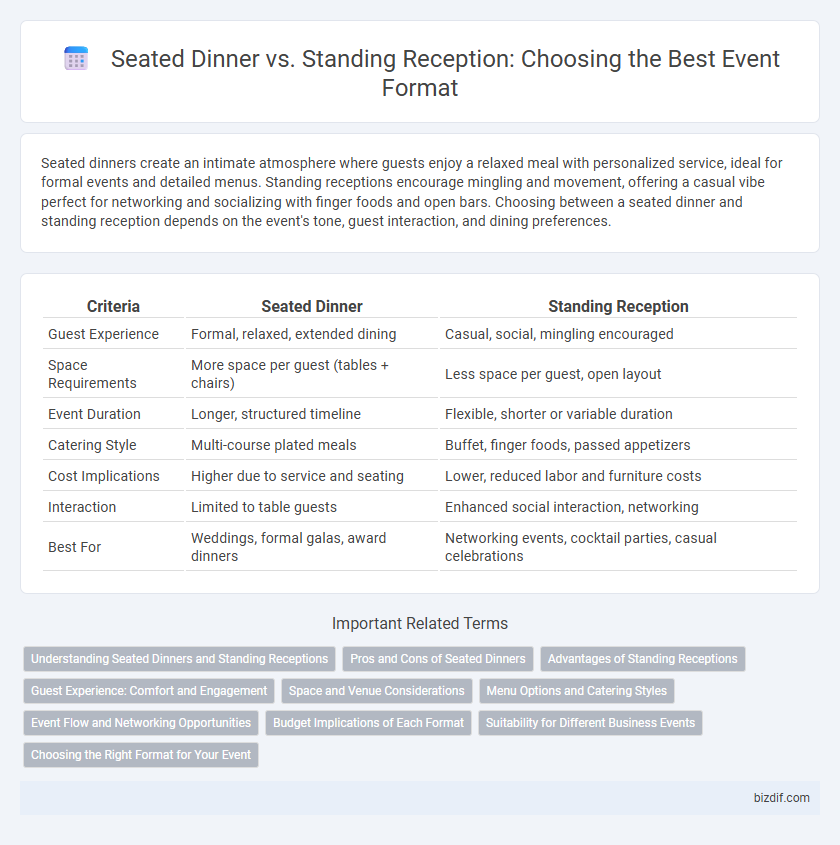Seated dinners create an intimate atmosphere where guests enjoy a relaxed meal with personalized service, ideal for formal events and detailed menus. Standing receptions encourage mingling and movement, offering a casual vibe perfect for networking and socializing with finger foods and open bars. Choosing between a seated dinner and standing reception depends on the event's tone, guest interaction, and dining preferences.
Table of Comparison
| Criteria | Seated Dinner | Standing Reception |
|---|---|---|
| Guest Experience | Formal, relaxed, extended dining | Casual, social, mingling encouraged |
| Space Requirements | More space per guest (tables + chairs) | Less space per guest, open layout |
| Event Duration | Longer, structured timeline | Flexible, shorter or variable duration |
| Catering Style | Multi-course plated meals | Buffet, finger foods, passed appetizers |
| Cost Implications | Higher due to service and seating | Lower, reduced labor and furniture costs |
| Interaction | Limited to table guests | Enhanced social interaction, networking |
| Best For | Weddings, formal galas, award dinners | Networking events, cocktail parties, casual celebrations |
Understanding Seated Dinners and Standing Receptions
Seated dinners provide a structured dining experience with assigned seating, ideal for formal events and allowing guests to enjoy multi-course meals comfortably. Standing receptions encourage mingling and networking by offering a more casual atmosphere where guests can move freely and sample a variety of hors d'oeuvres and drinks. Event planners must consider guest interaction, menu style, and overall event tone when choosing between seated dinners and standing receptions.
Pros and Cons of Seated Dinners
Seated dinners offer structured dining experiences with assigned seating, promoting intimate conversations and formal ambiance ideal for weddings and corporate events. They provide controlled meal service, reducing food waste and ensuring guests receive hot, personalized meals, but require more space and higher catering costs compared to standing receptions. Limitations include less guest mobility and reduced networking opportunities, making seated dinners less suitable for casual or large-scale social gatherings.
Advantages of Standing Receptions
Standing receptions offer greater social interaction opportunities by encouraging guests to mingle freely without the restrictions of seating. These events maximize space efficiency, accommodating a larger number of attendees within the same venue compared to seated dinners. Flexible food and drink stations in standing receptions enhance guest experience by providing a variety of options and fostering a dynamic, casual atmosphere.
Guest Experience: Comfort and Engagement
Seated dinners provide guests with comfortable seating, allowing for relaxed dining and easier conversation, which enhances engagement and enjoyment throughout the event. Standing receptions encourage mingling and movement, fostering dynamic social interaction but may cause discomfort over extended periods. Balancing guest comfort with opportunities for networking is essential in choosing between these event formats.
Space and Venue Considerations
Seated dinners require ample space for tables and chairs, typically needing more square footage per guest to ensure comfort and ease of movement. Standing receptions maximize venue capacity by allowing guests to mingle without fixed seating, ideal for smaller or unconventional spaces. Venue layouts, accessibility, and service logistics must be carefully evaluated to match the event's style and guest interaction preferences.
Menu Options and Catering Styles
Seated dinners typically feature multi-course meals with plated service, allowing for more elaborate and customizable menu options tailored to guests' preferences. Standing receptions favor buffet or passed hors d'oeuvres catering styles, emphasizing variety and ease of movement while encouraging social interaction. Selecting the right menu and catering style depends on the event's formality, guest count, and desired atmosphere.
Event Flow and Networking Opportunities
A seated dinner offers a structured event flow, allowing guests to engage in focused conversations at assigned tables while enabling smooth service and formal presentations. In contrast, a standing reception promotes dynamic mingling and spontaneous networking opportunities, fostering diverse social interactions and faster circulation among attendees. Event planners should balance guest interaction goals and logistical needs when choosing between seated dinners and standing receptions.
Budget Implications of Each Format
Seated dinners typically incur higher costs due to the need for more tables, chairs, and formal place settings, as well as increased staffing for service. Standing receptions often reduce expenses by minimizing furniture rentals and allowing for more flexible, buffet-style catering with fewer servers. Budget considerations should include venue capacity, desired atmosphere, and service levels when choosing between seated dinners and standing receptions.
Suitability for Different Business Events
Seated dinners are ideal for formal business events such as award ceremonies, client dinners, and board meetings, where long discussions and presentations are expected. Standing receptions suit networking events, product launches, and informal gatherings, promoting mingling and brief interactions. Selecting between the two depends on event objectives, guest engagement levels, and required ambiance to maximize business outcomes.
Choosing the Right Format for Your Event
Seated dinners offer a structured, formal atmosphere ideal for events requiring focused dining and conversation, while standing receptions promote mingling and networking in a more casual setting. Consider guest count, venue size, and event goals when selecting between the two formats to maximize comfort and engagement. Budget allocation also varies, as seated dinners often incur higher costs due to catering and seating arrangements compared to standing receptions.
Seated dinner vs Standing reception Infographic

 bizdif.com
bizdif.com